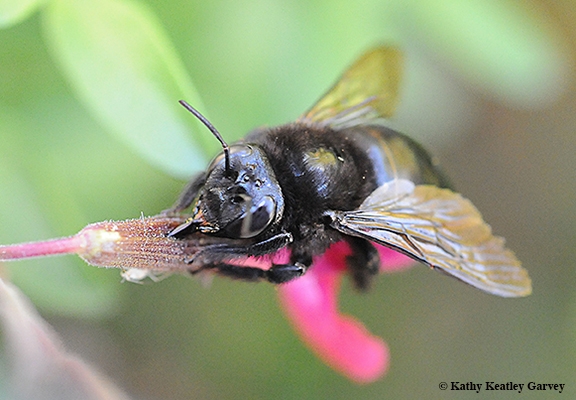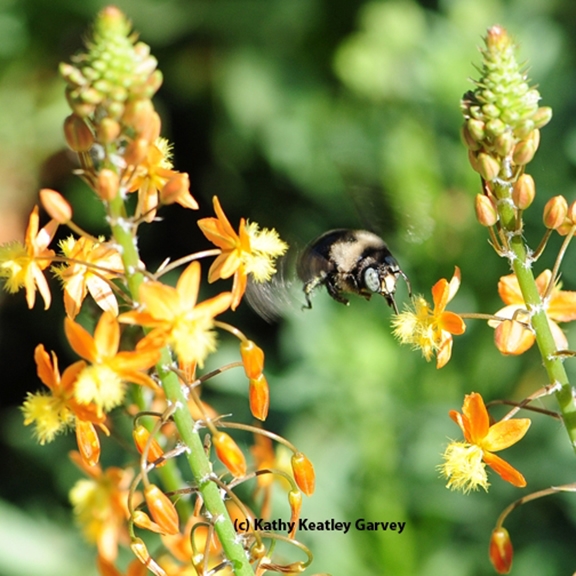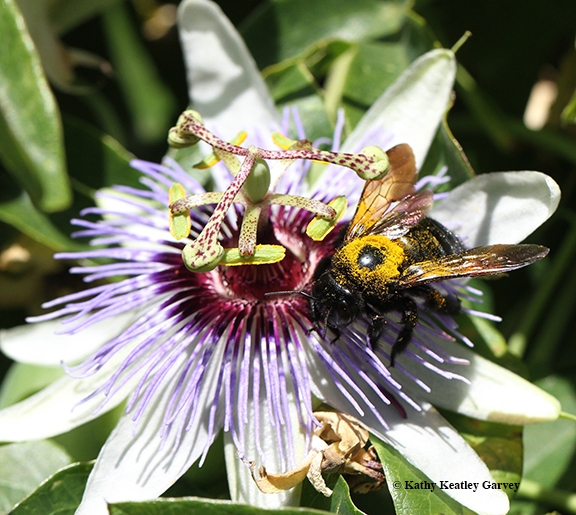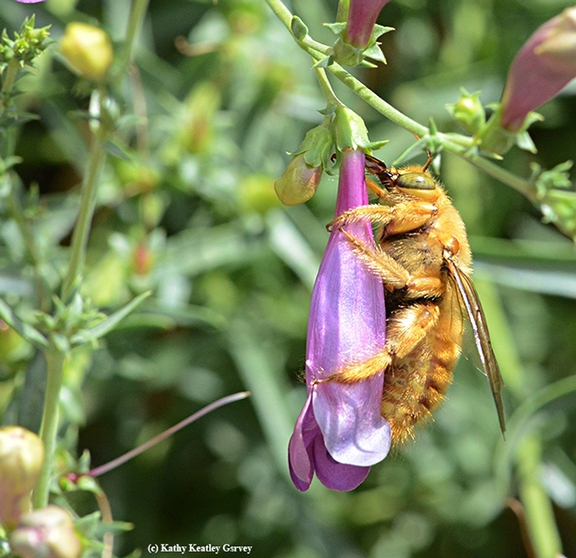
Posts Tagged: Xylocopa tabaniformis orpifex
Carpenter Bee: Beneficial Insect or Pest?
Let's face it--some folks are not fond of carpenter bees. Honey bees, yes! Bumble bees, yes! Carpenter bees, uhh, not so much. Ever seen carpenter bees drilling holes in dead limbs or untreated fence posts to build their nests? No? Well, you've probably seen them in their "robber role," piercing...

A female mountain carpenter bee, Xylocopa tabaniformis orpifex, pierces the corolla of salvia to rob the nectar. (Photo by Kathy Keatley Garvey)

A male mountain carpenter bee, Xylocopa tabaniformis orpifex, heads for bulbine. (Photo by Kathy Keatley Garvey)

A familiar sight: a female Valley carpenter bee, covered with pollen and nectaring on a passion flower. The female is solid black, while the male of this species is a green-eyed blond. (Photo by Kathy Keatley Garvey)

A male Valley carpenter bee, Xyclopa varipuncta, pierces the corolla of a foothill Penstemon. (Photo by Kathy Keatley Garvey)

Female carpenter bees, Xyclopa variuncta, often drill holes in limbs of dead trees to build their nests. This find, from Davis naturalist/photographer Allan Jones, shows a male wintering inside one of the holes. (Photo by Kathy Keatley Garvey)
The Nectar Robbers
If you have a patch of salvia (sage) growing in your yard, watch for the nectar robbers. Carpenter bees are among the insects that engage in nectar robbing. They drill a hole in the corolla of the flower, circumventing the usual plant-pollinator relationship. In other words, they're ...

Mountain carpenter bee, Xylocopa tabaniformis orpifex, engaging in nectar robbing. (Photo by Kathy Keatley Garvey)

Side view of nectar robbing by mountain carpenter bee on salvia. (Photo by Kathy Keatley Garvey)

Honey bee looks for the hole drilled by a carpenter bee. (Photo by Kathy Keatley Garvey)

Honey bee engaging in nectar robbing. (Photo by Kathy Keatley Garvey)
I've Been Robbed!
Bees need flowers that correspond to their body size and tongue length in order to effectively access the nectary located at the flower base, so a well-designed bee garden includes plants that provide a variety of flower shapes and sizes. Small bees with short tongues, for example, need...
Big on the Bulbine
Look at the Xylocopa on the Xanthorrhoeaceae. If that sounds like a mouthful, think of the mountain or foothill carpenter bees, Xylocopa tabaniformis orpifex, on bulbine from the genus Bulbine in the family Xanthorrhoeaceae. Carpenter bees and honey bees are among bees...

A male mountain carpenter bee, Xylocopa tabaniformis orpifex, nectaring on bulbine. (Photo by Kathy Keatley Garvey)

Male mountain carpenter bee, Xylocopa tabaniformis orpifex, caught in flight. (Photo by Kathy Keatley Garvey)
Robbing Nectar
We all take short cuts--short cuts around the campus, to the beach, to a favorite restaurant... Honey bees take short cuts, too. We've often watched assorted bumble bees and carpenter bees drill a hole in a long-tubed flower to rob the nectar. And we've watched honey bees benefitting from this...

Carpenter bee, Xylocopa tabaniformis orpifex, robbing nectar from salvia. (Photo by Kathy Keatley Garvey)

Honey bee gathering nectar from a carpenter bee's pierced hole in the long tube of a salvia. (Photo by Kathy Keatley Garvey)

Another honey bee reaping the benefits of nectar robbing by a carpenter bee. (Photo by Kathy Keatley Garvey)
